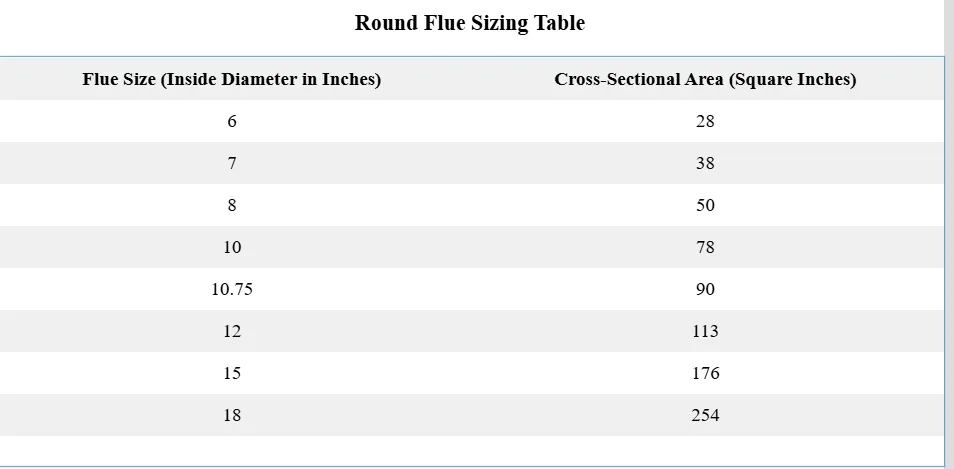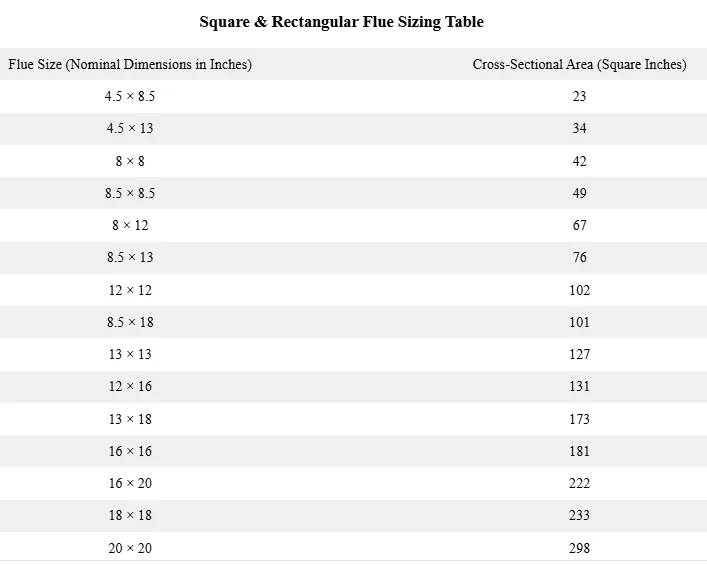When building or renovating a masonry fireplace, selecting the correct flue size is crucial for safety, efficiency, and compliance with building codes. An improperly sized flue can lead to poor draft, smoke backflow, or even fire hazards.
In this guide, we’ll break down the masonry fireplace flue size requirements based on industry standards (ASTM C315) and building codes (Section 2113.16). We’ll also provide easy-to-reference flue size charts for both round and square/rectangular flues.
Importance of Fireplace Flue Sizing
Flue sizing for chimneys serving fireplaces must follow established guidelines, ensuring optimal performance and adherence to safety standards. The proper flue size depends on the fireplace opening size, chimney height, and flue shape (round, square, or rectangular).
According to building codes, flue sizing follows:
- Round flues: Minimum cross-sectional area should be at least 1/12 of the fireplace opening.
- Square or rectangular flues (aspect ratio less than 2:1): Minimum cross-sectional area should be at least 1/10 of the fireplace opening.
- Rectangular flues (aspect ratio 2:1 or greater): Minimum cross-sectional area should be at least 1/8 of the fireplace opening.
Below is a comprehensive chart detailing the required flue sizes based on fireplace opening dimensions and chimney height.
Masonry Fireplace Flue Size Chart
Round Flue Sizing Table
| Flue Size (Inside Diameter in Inches) | Cross-Sectional Area (Square Inches) |
|---|---|
| 6 | 28 |
| 7 | 38 |
| 8 | 50 |
| 10 | 78 |
| 10.75 | 90 |
| 12 | 113 |
| 15 | 176 |
| 18 | 254 |
Note: Flue sizes are based on ASTM C315.
Square & Rectangular Flue Sizing Table
| Flue Size (Nominal Dimensions in Inches) | Cross-Sectional Area (Square Inches) |
| 4.5 × 8.5 | 23 |
| 4.5 × 13 | 34 |
| 8 × 8 | 42 |
| 8.5 × 8.5 | 49 |
| 8 × 12 | 67 |
| 8.5 × 13 | 76 |
| 12 × 12 | 102 |
| 8.5 × 18 | 101 |
| 13 × 13 | 127 |
| 12 × 16 | 131 |
| 13 × 18 | 173 |
| 16 × 16 | 181 |
| 16 × 20 | 222 |
| 18 × 18 | 233 |
| 20 × 20 | 298 |
| 20 × 24 | 335 |
| 24 × 24 | 431 |
How to Determine the Right Flue Size for Your Fireplace
1. Measure the Fireplace Opening
The first step in determining the correct flue size is measuring the width and height of your fireplace opening. Multiply these values to get the total square inches of the opening.
2. Choose the Correct Flue Type
Depending on whether you have a round, square, or rectangular flue, you will use the following formulas:
- Round flue: Opening area ÷ 12
- Square/rectangular flue (aspect ratio <2:1): Opening area ÷ 10
- Rectangular flue (aspect ratio ≥2:1): Opening area ÷ 8
3. Consider Chimney Height
The chimney height, measured from the firebox floor to the top of the flue, also influences flue performance. Taller chimneys create stronger draft, allowing slightly smaller flue sizes, while shorter chimneys may require larger flues for proper ventilation.
Common Mistakes in Flue Sizing
- Undersized Flue: A flue that is too small restricts airflow, leading to poor draft and excessive smoke entering the room.
- Oversized Flue: A flue that is too large reduces the efficiency of smoke evacuation, causing downdrafts and increased creosote buildup.
- Ignoring Chimney Height: Always consider the height of your chimney when selecting a flue size to ensure optimal performance.
FAQs
What is the purpose of a chimney flue in a masonry fireplace?
A chimney flue serves as the passageway for smoke and gases to exit the fireplace safely. It ensures proper ventilation, prevents backdrafts, and maintains efficient combustion in the fireplace.
How do I determine the correct flue size for my fireplace?
To determine the correct flue size:
Measure the area of your fireplace opening.
Apply the minimum area requirements based on flue shape: Round flues: Minimum area = 112121 of the fireplace opening.
Square or rectangular flues with an aspect ratio < 2:1: Minimum area = 110101 of the fireplace opening.
Rectangular flues with an aspect ratio ≥ 2:1: Minimum area = 1881 of the fireplace opening.
Why is proper flue sizing important?
Proper flue sizing is critical for:
Ensuring sufficient draft to vent smoke and gases.
Preventing issues like smoke backdrafts or excessive heat loss.
Complying with building codes and safety standards.
What happens if the flue size is too small or too large?
Too small: Insufficient draft may lead to smoke backup into the room, causing health hazards and inefficient combustion.
Too large: Excessive draft can cause the fire to burn too vigorously, wasting fuel and materials.
What are the standard sizes for round and rectangular flues?
Here are common sizes:
Round Flues: Diameters range from 6 inches (28 square inches) to 18 inches (254 square inches).
Rectangular Flues: Dimensions range from 4.5 × 8.5 inches (23 square inches) to 24 × 24 inches (431 square inches).
How does chimney height affect draft performance?
Increasing chimney height improves draft performance by creating a stronger upward pull for smoke and gases. However, this must be balanced with proper flue sizing to avoid inefficiencies.
Can I use a smaller flue liner for specific appliances?
Yes, certain appliances, such as DEFRA-approved stoves or gas fires, may allow smaller flue liners (e.g., 125mm diameter). Always consult appliance installation guidelines to ensure compatibility.
Are round flues better than rectangular ones?
Round flues are generally more efficient because exhaust gases spiral upward smoothly, reducing turbulence and maintenance needs. However, rectangular flues are often used due to construction preferences and aesthetic considerations.
How do I calculate the effective area of a rectangular or square flue?
For rectangular or square flues, subtract corner areas that do not contribute to airflow when calculating effective cross-sectional area. This ensures accurate sizing for optimal draft performance.
Are there specific building codes for masonry fireplace flues?
Yes, building codes specify minimum cross-sectional areas based on fireplace opening size and chimney height. These standards vary by region but typically align with ratios like 110101, 112121, or 1881 depending on shape and aspect ratio.
Conclusion
Selecting the right masonry fireplace flue size is essential for efficient combustion, proper draft, and safe operation. By following standard sizing guidelines and referencing the flue size chart above, you can ensure your chimney performs optimally while maintaining compliance with building codes.
If you’re unsure about your fireplace flue sizing, consulting a professional chimney expert can help you make the best decision for your home.!


Affiliate Disclosure: Fireplaceadviser.com is a participant in the Amazon Services LLC Associates Program. We may earn a commission when you click on certain links on this site and purchase.

Hello!! I am Jamal Khan. I often fix my home electric heaters and gas stove problems and research the common issues in the heating units to improve my knowledge and expertise. The aim of establishing fireplaceadviser.com is to share my expertise and knowledge with my audience.












